History of Occitania, part 1
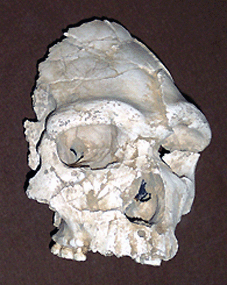 PREHISTORY
PREHISTORY In 1971, a human scull of a Homo Erectus was found in a cave near Tautavel. Tautavel man lived ca. 450.000 years ago in the Roussillon.
The oldest traces of human habitation in southern France are, however, almost 2 million years old, when the first African migration entered Europe.
Only much later, about 30.000 years ago, humans began to express themselves artis-tically by e.g. cave paintings.
BRONZE AGE
In this period the Ligurians, Iberians, Celts and Basques lived in southern France. They fought among themselves for possession of territory. People withdrew behind the walls of their oppidum, a hill fortress, of which many were found in southern France. Around 600 B.C. the first colonists from the Levant arrived in Europe. The Phoenicians founded Marseille and Agde, followed by Greek colonists. New Celtic tribes arrived from the north and the tribes called Arecomici and Tectosages also made their home here.
ROMAN RULE (125 BC to 5th century AD)
Only a few years after the arrival of the Romans in the Languedoc-Roussillon, Narbonne was founded. Domitius built the first Roman road, the Via Domitia, which would connect the Alps with the Pyrenees. In the year 27, the province of Narbonensis was founded. The southwest of France was called Gallia Aquitania, while the southeast was called Gallia Septimania. The latter was roughly the region of the Languedoc-Roussillon. The name Septimania probably came from the Roman name of Beziers, "Colonia Julia Septimanorum".
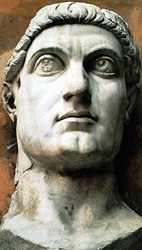 Early Christianity
Early Christianity The christian faith became more and more powerful, so Constantine the Great decided early in the 4th century AD, to allow christianity as a faith. Soon after he even chose christianity to be the official religion of the Roman Empire. It became apparant that a powerstate based on religion was much stronger than one that was without. In 324 the Council of Arles took place and the first church dogmas were decided upon. For some reason, France had a very important position in the early Roman powerstate.
The end of the Roman empire
In the course of the centuries, the Roman Empire was frequently under the threat of their own citizens. Displeased provinces or tribes made trouble and the borders became weaker. Also the Goths would rise against the empire. These gothic tribes came from the high north, probably Scandinavia, spread to Asia a few centuries B.C. and when they came further south in the 3rd century AD they met with the Roman Empire. Eventually they separated into two groups, the east Goths (Ostrogoths) and the west Goths (Visigoths). The bad treatment they received from the Romans finally made them rise against the Roman Empire. In 410 they even sacked Rome, which would be the beginning of the end of the western Roman Empire. The eastern Roman Empire is known as the Byzantine Empire, with their capital in Constantinopel, now Istanbul. After several years the Goths made peace with the Romans and the Visigoths were given permission to settle in southern France and Spain, where Roman power was losing its grip. In 475 the Visigoths were given complete independence.
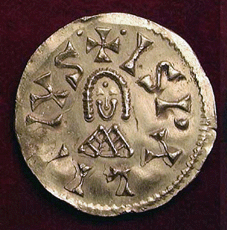 THE VISIGOTHS
THE VISIGOTHSAfter the fall of the Roman Empire, the Visigoths played an important role in European history for the next 250 years.
The Visigoths had adopted the Arian christian faith. This faith was not in tune with the new Roman Catholic faith that was establishing in the mean time. They remained faithful to Arianism until their king Reccared I was baptised in 589.
Glory and fall of the Visigoth Empire
Just before the Battle of Vouille in 507 against the Franks, the Visigoth kingdom reached its greatest glory. The realm included Aquitaine and the Iberian peninsula with the exception of a few pieces in the north (Basque country) and the northwest (the Suevi kingdom). In 507 the Merovingians conquered Aquitaine and in 554 Granada and Andalusia were conquered by the Byzantine Empire under Justinianus I, who was trying to re-conquer the west. In 584 the Visigoths conquered the Suevi kingdom and in 624 the southern properties were regained from the Byzantines.
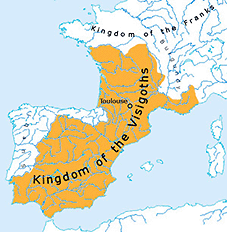 The Visigoth kingdom existed until 711, when king Roderik was killed while trying to stop the Amayyadi muslims from conquering their lands. The largest part of Spain fell under islamic reign very quickly after Roderik's death, and the Visigoths who refused to live under muslim reign and faith fled north to the kingdom of the Franks. During the Carolinian period the muslims were pushed back south. The Visigoths however, remained key figures in the realm of Charlemaine for many generations.
The Visigoth kingdom existed until 711, when king Roderik was killed while trying to stop the Amayyadi muslims from conquering their lands. The largest part of Spain fell under islamic reign very quickly after Roderik's death, and the Visigoths who refused to live under muslim reign and faith fled north to the kingdom of the Franks. During the Carolinian period the muslims were pushed back south. The Visigoths however, remained key figures in the realm of Charlemaine for many generations.Origin of the Visigoths
As there is little known about the origin of the Visigoths, we must take a look at the many cultural shifts that have taken place before the christian era. And very quickly the Phoenicians attract our attention. They went all over the place; Scandinavia, the British Isles and Ireland included. The Phoenicians were seafaring Canaanites, probably originally from the Indusvalley in India, and contemporaries with the Minoans from Crete who had established a very prosperous and peaceful society in this part of the Mediterranean from 3500 to approx. 1350 BC.
In this period there was a power struggle between two cultures. One culture (Minoan, notice their bull cult, the Minotaur, the Labyrinth and the Minoan bee images) was based on a society in which men and women were practically equal, in which they cherished science and which was very peaceful. Their god was always androgynous and mainly based on the Mother Goddess. The other culture was fond of power and possession, and in their society man was boss and women were cattle. Their religion was based on a dominant god, mainly male, sometimes even ruthless and evil. The Minoan civilisation had its zenith just before the eruption of the Santorini vulcano, after which Minoan culture gradually declined and melted with Agean and Mycene cultures. Many tribes went to the northwest around that time, fleeing from the cruelty of the expanding male god cultures.
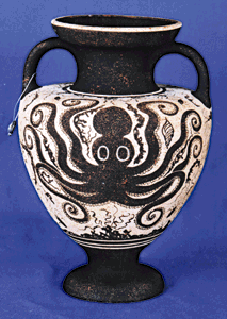 Dan
DanIn the same period, the nautical tribe of Dan was spreading. A branch of the Phoenicians (Canaanites) called the Pelasgians, were called the Danuna by the Egyptians and the Danaoi by Homer. This group of people lived in Greece and on Crete, were part of the Minoan culture, reigned by priestkings and they also had an androgynous goddess called Anu or Danu. They were also the ancestors of the legendary Tuatha de Danaan of Ireland. Part of the Danuna changed the name Anu into Io (the white goddess), a word which is still the root of our word for god (Io, Jove) and used in names as John. These were the Ionians who colonised the group of islands that we now know as the Ionian Islands in Greece. The religious capital of the Danuna was Argos on the Greek peninsula called the Peleponessos. Here stood the Io temple.
The Pelasgians were named after their king Pelasgus I, the first king of Arcadia (Peleponessos). The name Arcadia would get into use after the rule of his follower Arcas I. From that moment on these people were called the Arcadians. The Egyptian knowledge of Thot, also known as the Hermetica, was very popular in early Greece and in the Minoan culture. The number of Thot is 8 (Cosmic balance - as above so below) and was symbolised by the octopus (see the Minoan vase on the photo on the left). There were great contacts between Egypt and Greece, especially Crete. Greece was therefore already well ploughed earth for the growth of philosophy, made famous by the later Greek philosophers like Plato and Aristotle. When the Egyptian Thot became the Greek Hermes, they even had him born in Arcadia and melted with the ancient god Pan.
After the Phoenicians had taken Argos, the mythical journey of the Argonauts took place to Colchis, where they had to find the Golden Fleece. The Order of the Golden Fleece is one of the highest awards in the world and is given mainly to the high nobility. The order was founded in 1430 by Philip the Just of Burgudy as a sort of neo-templar group. The order was dedicated to the holy virgin and St. Andrew.
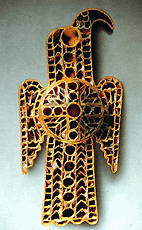 The people of Danuna, now called the Arcadians, would journey to far away places like Denmark, Great-Britain and Ireland (from ca. 13th century BC). Their Zodiac sign is Scorpio (Eagle). They are said to have named the river Jordan early in Dan's history, and on their journey from the Mediterranean they also named the river Danube.
The people of Danuna, now called the Arcadians, would journey to far away places like Denmark, Great-Britain and Ireland (from ca. 13th century BC). Their Zodiac sign is Scorpio (Eagle). They are said to have named the river Jordan early in Dan's history, and on their journey from the Mediterranean they also named the river Danube.According to the early historian Jordanes (interesting name by the way), who wrote the 'Origin and Deeds of the Goths' (the Getica) in the 6th century and who is himself a descendant of the Goths, there was a tribe called the Dani on the isle of Scandza (Scandinavia) several centuries B.C.. The Dani lived in Jutland in Denmark (Danmark).
Jordanes spoke also of the Sueti (from Sweden) and the Goths (from Gotaland, Sweden). Incredible numbers of Goths would travel to Scythia.
In the Irish history the Tuatha de Danaan arrived about a millennium before the christian era. Also England has traces of their presence, we only need to look at the name, Albion, the old name for England. Albion, like Io, means White Goddess (Albi = white and On or Anu means goddess). The Visigoths also used the eagle symbol, which might refer to their origins, the tribe of Dan.
In Egypt, On was the ancient name for Heliopolis, the city of the sun cult. In Hellenistic times, Helios was the sungod (probably derived from Aton). Hellas was the name of ancient Greece. Aaron was the highpriest of Heliopolis just before the Exodus. Heliopolis was the (male?) counterpart of Hermopolis, the city of Hermes (Thot). It is clear that the ancient knowledge of the Egyptians (the later Hermetica and Gnocism) would spread to Greece and Europe thanks to the Greeks and Greek philosophers. It is said that on the flag of the Grail Knights, who served the legendary king Arthur, a sundisc can be seen. Also, two of the Trencavel lords of Carcassonne had an interesting middle name: Aton. Hermetism quickly took root in the Minoan civilisation, the later Visigoth and Merovingian society and the Cathar culture. It is very probable that during the glory times of the Visigoths and Merovingians, an effort was made to create an Hermetic state based on knowledge (Gnosis), after the example of the Arcadian and Minoan Empire.
The origin of the Visigoths through the tribe of Dan would lead us back to Greece (Pelasgians/Danuna/Arcadians), Egypt (through Dan himself, son of Jacob) and Phoenicia (Canaan), probably even India. The tribe of Dan's origin was therefore Phoenician (Canaan). Would this name refer to the Biblical story of Cain who killed his brother Abel out of jealousy and moved (from India?) to another realm?. Must we look to the Veda's of the Indus Valley as the origin of wisdom and what we now know as the Hermetica? We could compare the Hyksos with the Mitanni from northern India to follow the origins of the Egyptian Mystery School all the way back to the Indian Veda culture.
The Egyptians called the Phoenicians "Hyksos", and one of the Hyksos kings who ruled Egypt was coincidentally called Yaqob-her (15th Dynasty - Mer-woser-ra Yaqob-her, probably the 3rd king of the Hyksos).
These Biblical stories can of course be based on true historical happenings, however, they can also be stories to show the shifts of cultures which happened in ancient times. It may reveal how the Phoenicians spread to Egypt, Greece, Europe and Scandinavia, how a part of them returned from Scandinavia and settle in France and Spain as the Visigoths. And thus came (Cretan born) Hercules to the Pyrenees. In these southern areas of France and Spain one would later try to resist the forces of the Roman catholic empire. The Visigoths in southern France and Spain kept their original Arian faith a long time before they adopted the catholic way of life. And not to forget the Cathars of course. The fight between the two cultures which started millennia before our christian era, would continue long after the christian era...
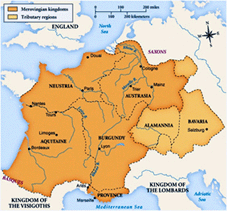 THE MEROVINGIANS
THE MEROVINGIANSThe Merovingians were a special dynasty of Frankisch kings, who ruled an ever changing territory in the area of present France, southern Holland, Belgium and western Germany from the 5th to the 8th century. This is a subgroup of Salian Franks, who have separated from Germanic tribes in an earlier stage. Their name, Frank, means 'bold' or 'brave'. In the 2nd century they lived mainly in the Rhinedelta area. The river IJssel (Isala) was named after them as well as Salland. The Salian Franks (Franci Salii) are therefore responsible for the Birth of the Dutch culture and society. The name Sal comes from the word for salt. The trade in salt was since the Celts, whose name also comes from the ancient word for salt, very prosperous indeed and salt was also named: White Gold. From the 2nd century onwards the Franks moved more and more southward, until they reigned quite a substantial territory. The Salian Law (Lex Salica in Latin) dates from the early 6th century, from the days of king Clovis I, who was king of the Salian Franks. In his realm several different tribes lived together and he needed the Salian Law to maintain the order in his land. This Salian Law would form the basis of the Carolingian laws, which would be maintained until the 12th century.
Austrasia and Neustria
Austrasia was the northern part of the Merovingian kingdom, and consisted of the east of France, western Germany, Belgium and Holland. The capital of the realm was Metz, however they did also reign from Reims. Neustria was created in 511, when Clovis died. After the death of this Frankish king, his kingdom was divided between his four sons. Theuderic I of Austrasia became ruler of the eastern part. Austrasia and Neustria were never really at peace with one another. In 613 the two realms were taken over by Clothar I, who had his capital in Paris. The two realms, however, quickly fell apart again. Only when Pepin of Herstal conquered Neustria in 687, the two realms were united once and for all. When his grandson, Pepin the Short, became king of the Franks and also conquered Burgundy, names and inner borders faded away and one would only speak of the Kingdom of the Franks.
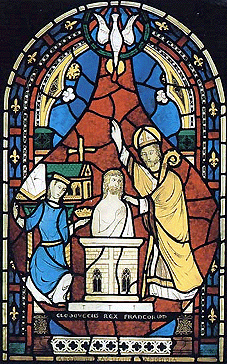 The Merovingian kings
The Merovingian kingsThe Merovingian dynasty got its name from Merovech, king of the Salian Franks from 447 to 458. His son Childeric I conquered the Visigoths in the second half of the 5th century and his grandson, Clovis I, was able to unite the largest part of Gaul north of the Loire by adapting himself to the increasing power state of the Roman catholic faith. Therefore he is also responsible for spreading catholicism in France and surrounding realms. In 496 Clovis was baptised by bishop Remi in Reims, one of the main cities of the Merovingians.
Reims
In Reims, the capital of the Champagne province, almost all French kings were crowned and anointed until 1825, a tradition which goes back to the baptism of Clovis I. During his anointment, oil from a small container was pored on his head. The oil was, according to legend, brought to him by a dove. The anointment of kings with messeh oil goes back to Biblical times. Louis I the Pious was crowned emperor in Reims in 816. But the most famous coronation is perhaps that of Charles VII in 1429, during the Hundred Year War: the Dauphin was brought to Reims by Joan of Arc, after she had conquered the city from the English-Burgundy allience. The story of Joan of Arc (Jehanne Darc), who died on the stake accused of herecy, is clouded in mystery. She probably, with the help of Renée d'Anjou, tried to realise an Hermetic State after the failing of the Knights Templar, but found harsh enemies in the Roman catholic church. Another great man, Napoleon Bonaparte, was crowned in the Notre Dame in Paris, wearing a royal robe featuring lots of golden bees....
Feudalism
The Merovingians are also responsible for the origin of feudalism, when they let their dukes reign in stead of their kings. The Languedoc-Roussillon was from that moment on reigned by feudal lords for many centuries. These are the so called Lords of the Languedoc, who would later protect the Cathars against the catholic crusades. The soldiers who maintained the order were also called Knights for the first time in history.
Towards the 7th century, the Merovingian kings had little power and were more symbolic figures. They left the state to the rule of major domos (stewards). The position of Major Domo became hereditary in Carolingian times. The Carolingians dethroned the Merovingians in 751, when Pepin the Short was joined by Frankish noblemen and they no longer recognised their king Childeric III.
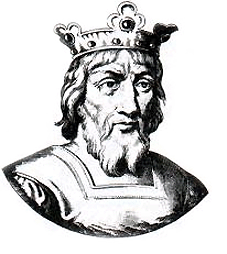 Origin of the Merovingians
Origin of the MerovingiansThe Merovingian dynasty has a mysterious origin. Legends tell us of a special bloodline which would connect them to biblical tribes. Like the old Nazoreans, they didn't shave the hair on their heads. They would be descended from the Arcadians. And, they had the right to be kings when they reached the age of 12. The name Merovingian started with king Merovech, son of Clodio. With him, this mysterious bloodline started. Merovech (447-458) would be the son of an ancient seamonster called the Quinotaur according to a 7th century legend. His mother, the wife of Clodio, would have mated with this creature while bathing in the Mediterranean. There is so little known about Merovech, that one would believe that his history was wiped from the annals. Let us go back in time and see what may have happened.
The Arcadians
The Arcadians were a special people, who lived on the Peleponessos peninsula in Greece. The province of Arcadia is an area where shepherds live. In the Renaissance, for some reason, the theme 'Shepherds of Arcadia' was a favourite topic, especially for paintings, and usually along with the phrase 'Et in Arcadia ego'. The old god of Arcadia was Pan, the protector of the shepherds. This is also the old god of the biblical tribe of Dan, who is known to have spread quite a bit, they even reached the Balkan and northwestern Europe. Also this tribe of Dan lived in Arcadia. After a fight with the other tribes of Israel, the tribe of Benjamin would join them in Arcadia. Fragments of this historical happening have been found in several writings.
The name Arcadia is based on the Ursus Minor starsystem, the Little Bear, called Arcas, after the legendary king of Arcadia, Arcas I. The Little Bear is together with the Great Bear and the Pole Star (Polaris is the tale's end of the Little Bear) important for navigation. The Polestar was seen as the pillar around which the universe turned and compared to the Djed pillar and the Osiris Pillar. The stars gave them light and direction and so also they, the Arcadians, would give light and direction and be pillars on which the society could turn and rest.
After the eruption of the Santorini vulcano, there was a period of cultural shifts. The powers of the Minoan empire were weakening and the Mycenean and Dorian cultures were becoming more and more important. As the tribe of Dan was nautical, they probably decided to move away by sea. They sailed by Samos to the Turkish coast and settled on the land which was called Dardania after them. Also the Dardanelles were named after them. The kingdom of Dardania would become very powerful and around 1300 BC Troy was founded. The royal house of Troy would soon become very powerful. Their kings were legendary and claimed descendence from Hermes (Mercurius). Even the Romans said they descended from the Troyan king Aeneas.
After the Troyan war, many had to flee. And so also the Dardani arrived in the Balkan area of Europe. They settled in Pannonia around 1200 BC and are known as a Tracian-Illyrian tribe. According to Dionysius of Halicarnassus (2nd century) the Dardani were indeed from Arcadia.
When we look at the earliest data known about the origin of the Franks, we read that they were originally from Pannonia and according to their own story they even founded Troy. So there must be some kind of link between the Dardani and the Franks. It wasn't until 11 BC that they were called 'Franks' after their great leader Franco. The Franks would also live in Friesland, Gelderland and the lower Rhine delta area of southern Germany and the Netherlands.
If this is what has happened, than there is quite a resemblance between the origin of the Goths and the origin of the Franks. While the Franks would concentrate on a more southern area, the Goths would travel back to the Balkan several centuries BC, along a similar route as when they came to Scandinavia almost a thousand years earlier.
However, the Merovingians have taken over several characteristics from the tribe of Benjamin from about the time of king Merovech. But why was the tribe of Benjamin so important, that the Merovingians would feel they were of higher stock than the Visigoths, who also started out as Arcadians long long ago.
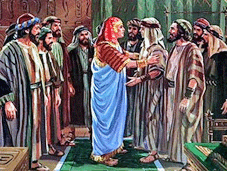 Benjamin
BenjaminThe tribe of Benjamin is quite a story. They were the chosen ones, and according to their birthright they would produce kings and were the legal heirs of the holy city of Melchizedek, Urusalem, the 'city of peace'. Since the first days of the existence of their tribe back in Egypt, where they were educated in the ancient Egyptian Mysteries at the court of the pharaoh (their brother Joseph was second to the king according to the biblical story), the tribe of Benjamin was the protector of the ancient knowledge and their women would automatically be priestesses of the Mother Goddess. They were the Healers, the watchers of the tower. This tribe would probably also produce the Zadok priests. These were high priests who would follow the teachings of Melchizedek (Michael Zadok) and were called the Sons of Light, Sons of God, the Just or Teachers of Righteousness. Also they were called Pillars or Towers. The name Benjamin is derived from Benu Yamina, meaning 'Sons of Righteousness'. Their Zodiak sign is Gemini.
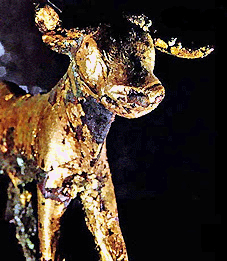 The Benjaminites also had a special reverence for the cow, bull or calf, of which they carried small images. This has its roots in the Phoenician (Canaanite) culture. The bull cult, which was also professed in the Minoan realm, is also based on the Mother Goddess and both Mother Goddesses (cow, bull, calf and Anu) were both male and female. The trinity of the bull, the cow and the calf is also shown in the myth of Osiris, Isis and Horus. The fact that Akhnaton ca 1350 BC would allow the Minoan bull cult together with his Aton cult, probably to please his wife Nefertiti who was from Crete, does attract attention. The worship of the golden calf (around 1350 BC) is a chapter of the biblical Exodus story, when Aaron allowed this cult but Moses became really upset.
The Benjaminites also had a special reverence for the cow, bull or calf, of which they carried small images. This has its roots in the Phoenician (Canaanite) culture. The bull cult, which was also professed in the Minoan realm, is also based on the Mother Goddess and both Mother Goddesses (cow, bull, calf and Anu) were both male and female. The trinity of the bull, the cow and the calf is also shown in the myth of Osiris, Isis and Horus. The fact that Akhnaton ca 1350 BC would allow the Minoan bull cult together with his Aton cult, probably to please his wife Nefertiti who was from Crete, does attract attention. The worship of the golden calf (around 1350 BC) is a chapter of the biblical Exodus story, when Aaron allowed this cult but Moses became really upset.Because certain cultural aspects of people, such as idols, names and symbolism, can reveal the origin of their ancestors, we must especially take notice of names like Ursus (bear), idols of a bull, cow or calf (preferably in gold), images of bees and rituals like those of the Zadok priests. The most important Zadok ritual is the thanksgiving ritual for the Mother Goddess for her food and water, for which bread was broken and wine was shared. At first, this ritual was only for the Zadok priests; now the ancient ritual of Melchizedek is bend and known as the Eucharist (derived from the Greek word for Thanksgiving), better known as the Holy Consecration, and this ritual is now only allowed to catholic priests.
Around the year 1000 BC the Phoenicians (Canaanites) and the Arcadians navigated to realms overseas, colonies were founded and traces of ancient Phoenician can be found in the Irish-Celtic language. So it is clear that these people were widely spread over Europe. It is therefore very possible that the ancient colonists of Europe originated from biblical tribes such as Benjamin and Dan. The Mythological Europe wasn't just abducted by Zeus in the image of a bull without having a symbolic meaning.
That there were Merovingian kings who had additional names such as Ursus, were burried with golden bees and images of a bull or cow, could support their connection with Benjamin and/or Dan. Their right to rule could be compared to Benjamin's right to rule. But this mysterious dynasty begins only with Merovech, son of the Quinotaur, a seamonster who could get into any shape. Merovech succeeded his (step?)father Clodio and became the first of a dynasty that would be called the "Merovingians", the fisherkings. A dynasty starts with a certain bloodline, and is therefore family bound. We could assume that the father of Merovech was not Clodio, but someone else. Or, Clodio's wife was the one to introduce the new bloodline. And because a seamonster is no option, we must look elsewhere for an explanation. In the myth, Merovech had two fathers, so perhaps it symbolises two bloodlines coming together leading to Merovech. The term seamonster may point towards someone originally coming from overseas. The name Quinotaur also contains the word 'taur' which means bull and this could point towards the bull cult of the Minoans. The word resembles Minotaur, the mythical half man half bull of Minoan Crete. Is there perhaps a symbolic connection between these two myths?
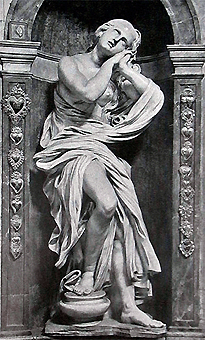 As it is quite difficult to prove that the ancestors of the Salian Francs and Merovingians would continue a pure royal bloodline of Benjamin as suggested by the Merovingians, we must look towards another legend, that of Mary Magdalene, who would arrive in France as a refuge. Would this legend try to tell us that a royal family from Judea would come to southern France in exile, to continue the royal bloodline there? According to historian and Dead Sea Scrolls expert Barbara Thiering this most certainly happened, in the year 44 or 45 to be exact. The group probably travelled via Alexandria in Egypt. The boat would have been bound for Marsilla (Marseille) but got stranded in the Camarque (Herault/Provence) after a storm. The Camarque of course was the Roman province of Gallia-Septimania.
As it is quite difficult to prove that the ancestors of the Salian Francs and Merovingians would continue a pure royal bloodline of Benjamin as suggested by the Merovingians, we must look towards another legend, that of Mary Magdalene, who would arrive in France as a refuge. Would this legend try to tell us that a royal family from Judea would come to southern France in exile, to continue the royal bloodline there? According to historian and Dead Sea Scrolls expert Barbara Thiering this most certainly happened, in the year 44 or 45 to be exact. The group probably travelled via Alexandria in Egypt. The boat would have been bound for Marsilla (Marseille) but got stranded in the Camarque (Herault/Provence) after a storm. The Camarque of course was the Roman province of Gallia-Septimania.It all sounds very logical. Mary Magdalene (Myriam Migdal Eder) was heir to the tribe of Benjamin through her father, and she was a priestess of the Mother Goddess, Healer and Watcher of the Tower. Her bloodline would go back as far as Aaron, the Zadok Priest. The name Migdal Eder means Watcher of the Tower, and this name would get altered through time to Magdalene. On top of this all, the catholic church was fond enough of this story, as is proven by a beautiful glass-in-led window in Chartres cathedral, on which Mary Magdalene's arrival is shown.
 Would Merovech be a descendant of Mary Magdalene? The name Merovech can be taken apart in Mer (sea, Myriam or Mary, mother) and Vech (to carry - vehere/vexi). The variant "Merving" could also be derived from Mer (sea, Myriam or Mary, mother) and Ving (vine or vineyard - vinea). So the term 'carriers of the vine' could be a translation for the name Merovingians. The vine in later legend does refer to the bloodline of Jesus and Mary Magdalene.
Would Merovech be a descendant of Mary Magdalene? The name Merovech can be taken apart in Mer (sea, Myriam or Mary, mother) and Vech (to carry - vehere/vexi). The variant "Merving" could also be derived from Mer (sea, Myriam or Mary, mother) and Ving (vine or vineyard - vinea). So the term 'carriers of the vine' could be a translation for the name Merovingians. The vine in later legend does refer to the bloodline of Jesus and Mary Magdalene.One of the darker pages in the old history of France is the faul murder of Dagobert II. Dagobert II was a king of the Merovingians. He married the Visigoth noble woman Giselle de Razes, niece of the Visigoth king in 671. They were married in the little chapel of La Madeleine in Rennes-le-Chateau, then still called Rhedae. Dagobert and Giselle lived there for several years. But the Merovingian realm was big and mighty, the king was very rich and powerful. As Dagobert refused to become catholic, he had to be 'removed'. On one of his travels he was brutally murdered in the Belgian Ardennes. His son Sigisbert IV was quickly brought to Rhedae in the safe south of France. The Roman catholic church regretted this deed very much, as Dagobert II was canonised in 872 and was even given a name day, 23rd December, coincidentally also a holy day for the tribe of Benjamin.
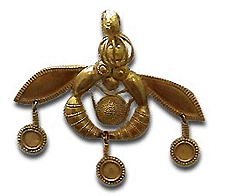 It attracts attention that hundreds of golden bees were found in the tomb of Childeric I. There are also Minoan golden bees (Museum in Heraklion) and there were even golden bees in the Hyksos period in Egypt. These were given as an honorary award for bold warriors. The bee was, by the way, also the symbol of the Essenes/Theraputae, where also Jesus was a member of.
It attracts attention that hundreds of golden bees were found in the tomb of Childeric I. There are also Minoan golden bees (Museum in Heraklion) and there were even golden bees in the Hyksos period in Egypt. These were given as an honorary award for bold warriors. The bee was, by the way, also the symbol of the Essenes/Theraputae, where also Jesus was a member of.Much older is the symbol of the Fleur de Lys, the French lily, which has its origin in ancient Egypt and India. It was the symbol of king Salomon, who had it on his crown. The Fleur de Lys symbolises the sacred lotus flower, which has been the symbol of the human covenant with God. Later it became the symbol of the holy origin of the Merovingians, and after Clovis it became the symbol of the Frankish christian kingdom.